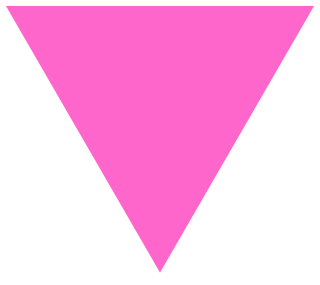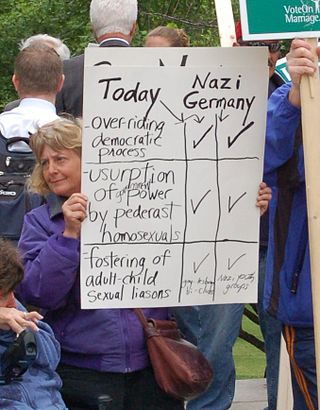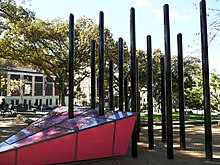
A pink triangle has been a symbol for the LGBT community, initially intended as a badge of shame, but later reappropriated as a positive symbol of self-identity. In Nazi Germany in the 1930s and 1940s, it began as one of the Nazi concentration camp badges, distinguishing those imprisoned because they had been identified by authorities as gay men or trans women. In the 1970s, it was revived as a symbol of protest against homophobia, and has since been adopted by the larger LGBT community as a popular symbol of LGBT pride and the LGBT movements and queer liberation movements.

The LGBTQ community is a loosely defined grouping of lesbian, gay, bisexual, transgender, and queer or questioning individuals united by a common culture and social movements. These communities generally celebrate pride, diversity, individuality, and sexuality. LGBTQ activists and sociologists see LGBTQ community-building as a counterweight to heterosexism, homophobia, biphobia, transphobia, sexualism, and conformist pressures that exist in the larger society. The term pride or sometimes gay pride expresses the LGBTQ community's identity and collective strength; pride parades provide both a prime example of the use and a demonstration of the general meaning of the term. The LGBTQ community is diverse in political affiliation. Not all people who are lesbian, gay, bisexual, or transgender consider themselves part of the LGBTQ community.

Biphobia is aversion toward bisexuality or people who are identified or perceived as being bisexual. Similarly to homophobia, it refers to hatred and prejudice specifically against those identified or perceived as being in the bisexual community. It can take the form of denial that bisexuality is a genuine sexual orientation, or of negative stereotypes about people who are bisexual. Other forms of biphobia include bisexual erasure.

Nazi concentration camp badges, primarily triangles, were part of the system of identification in German camps. They were used in the concentration camps in the German-occupied countries to identify the reason the prisoners had been placed there. The triangles were made of fabric and were sewn on jackets and trousers of the prisoners. These mandatory badges of shame had specific meanings indicated by their colour and shape. Such emblems helped guards assign tasks to the detainees. For example, a guard at a glance could see if someone was a convicted criminal and thus likely of a tough temperament suitable for kapo duty.

The bisexual flag, also called the bisexual pride flag, is a pride flag representing bisexuality, bisexual individuals and the bisexual community. According to Michael Page, the designer of the flag, the pink stripe represents attraction to the same sex, while the blue stripe represents attraction to the opposite sex. The purple stripe, the resulting "overlap" of the blue and pink stripes, represents attraction to both sexes.

The Homomonument is a memorial in the centre of Amsterdam, the capital of the Netherlands. It commemorates all gay men and lesbians who have been persecuted because of their sexual orientation. Opened on 5 September 1987, it was the first monument in the world to commemorate gays and lesbians who were killed by the German Nazi regime.

A pride flag is any flag that represents a segment or part of the LGBTQ community. Pride in this case refers to the notion of LGBTQ pride. The terms LGBTQ flag and queer flag are often used interchangeably.
Over the course of its history, the LGBTQ community has adopted certain symbols for self-identification to demonstrate unity, pride, shared values, and allegiance to one another. These symbols communicate ideas, concepts, and identity both within their communities and to mainstream culture. The two symbols most recognized internationally are the pink triangle and the rainbow flag.

The Pink Swastika: Homosexuality in the Nazi Party is a 1995 pseudohistorical book by Scott Lively and Kevin Abrams. Drawing on Samuel Igra's 1945 book Germany's National Vice, Lively and Abrams argue that the crimes committed by homosexuals in the Nazi Party exceed the persecution of homosexuals in Nazi Germany and that homosexuality contributed to the extreme militarism of Nazi Germany. They contend that only feminine homosexuals were persecuted by the Nazis, while "butch" homosexuals formed the leadership cadre of the Nazi party. Historian Andrew Wackerfuss criticized the book for lack of accuracy and "outright homophobic charges". The claim advanced by Igra, Lively, and Abrams that homosexuals were responsible for Nazi atrocities is rejected by most historians.

Bisexual erasure, also called bisexual invisibility, is the tendency to ignore, remove, falsify, or re-explain evidence of bisexuality in history, academia, the news media, and other primary sources.

The Memorial to Homosexuals persecuted under Nazism in Berlin was opened on 27 May 2008.

Bisexuality is a romantic or sexual attraction or behavior toward both males and females, to more than one gender, or to both people of the same gender and different genders. It may also be defined to include romantic or sexual attraction to people regardless of their sex or gender identity, which is also known as pansexuality.

The Pink Triangle Park is a triangle-shaped mini-park located in the Castro District of San Francisco, California. The park is less than 4,000 square feet (370 m2) and faces Market Street with 17th Street to its back. The park sits directly above the Castro Street Station of Muni Metro, across from Harvey Milk Plaza. It is the first permanent, free-standing memorial in America dedicated to the thousands of persecuted homosexuals in Nazi Germany during the Holocaust of World War II.

The memorial to gay and lesbian victims of National Socialism is a monument in Cologne, Germany, dedicated to the gay and lesbian victims of the Nazis.

Kind Space is an LGBT community centre located in Ottawa, Ontario, Canada. They are the oldest registered LGBT-specific charity in Canada, becoming registered in 1984. The organization serves gay, lesbian, bisexual, transgender, Two-Spirit, non-binary, queer, questioning, intersex, asexual, QTBIPoC, of all ages within the National Capital Region. They provide a number of services including support groups, education, research, advocacy and community space.
The Sydney Pride Centre was established in 1989 by PRIDE Sydney Lesbian and Gay Community Centre Limited, with a mission to 'establish a permanent community centre for the diversity of lesbians and gay men in Sydney and to build a vital, visible and positive community.' Initially focused on fundraising and establishing the right organisational framework, early fundraising parties were produced by PRIDE and in conjunction with Bacchanalia, Sweatbox, ACON and Prasit. The Founding board included Gary Cox, Adrian Gough, Gigi Legenhausen, Gillian Minnervini, Paul Nicholson, Philippa Playford, Malcolm Thorne, David Wilkins and Rob Williams.

The following outline offers an overview and guide to LGBTQ topics:

There is a widespread and long-lasting myth alleging that homosexuals were numerous and prominent as a group in the Nazi Party or the identification of Nazism with homosexuality more generally. It has been promoted by various individuals and groups from before World War II through the present, especially by left-wing Germans during the Nazi era and the Christian right in the United States more recently. Although some gay men joined the Nazi Party, there is no evidence that they were overrepresented. The Nazis harshly criticized homosexuality and severely persecuted gay men, going as far as murdering them en masse. Therefore, historians regard the myth as having no merit.














